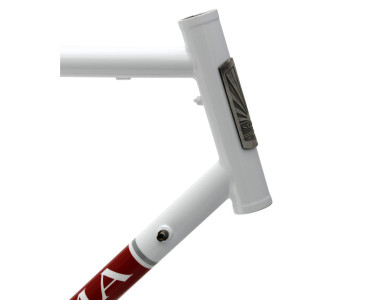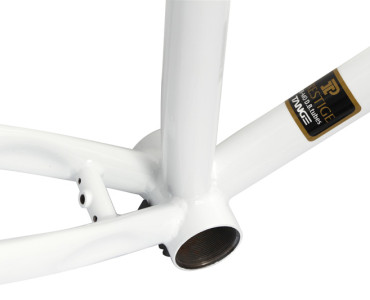Grand Randonneur Frameset (v.2) (Light Touring/Randonneuring)
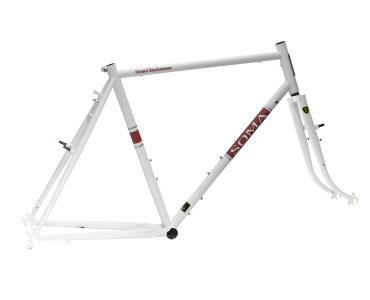
[This model is RETIRED. A new version updated for disc brakes and thru-axle hubs is coming out in March/April 2021.]
Our Grand Randonneur is a true low trail geometry randonneuring frame set, which means it rides better with a front load than other touring and road bikes. Co-designed with Mike Kone of Rene Herse/Boulder Bicycles. It will fit all the gadgets a good rando bike should have. The traditional diameter tubes lend a smooth comfortable ride.
- Tange Prestige CrMo tubes, double-butted, non-oversized
- Threaded 1" lugged fork with low rider pannier bosses, mini rack eyelets and double eyelets at the dropouts
- Rear rack and fender eyelets
- Pump peg
- 3 sets of water bosses
- Designed for 650b wheels and cantilever brakes
- Rear hub spacing: 132.5mm (fits either 130 or 135mm spaced hubs0
- Max. tire fit: 650 x 42mm slick tires w/fenders
- Max. fender width: 50mm
- Headset type: 1" ISO Threaded external cups(EC30/25.4| EC30/26) Needle/Roller bearings recommended
- Weight: Frame: 4.5 lbs Fork: 2.05 lbs
- Paint: White
Grand Randonneur Frameset (v.2) (Light Touring/Randonneuring)
-
Things to Know About Riding A Low Trail Randonneuring Bike
There are growing ranks of cyclists who prefer a low trail bike, primarily because of the way it handles with a medium front load like a handlebar bag. The Grand Randonneur and bikes like it has a fork offset 20mm or more than the average road bike. When carry a load up front the bke responds less to the weight of the bag while steering. Riding the bike without a load takes getting used to if you are coming from a conventional (mid trail) road bike or mountain bike. The Grand Randonneur uses lighter tubing than our other road bikes and a fork with a more pronounced bend to create a more comfortable ride over long distances. Because of that and the low trail design, we don't recommend it for fully loaded touring. It is a performance bike designed for carrying a light to medium front load in relative comfort over long distances.
A low trail bike is not necessarily a great fit for every rider and their bike needs
These observations from Bicycle Quarterly and others may help you determine if you want to try it out and help fine tune the ride of your bike.
1) Low trail bikes ride best with tires at least 36mm wide and preferably at lower tire pressure (55-60psi). Some claim 42mm is ideal
2) Low trail bikes handle differently than most bikes you've tried. It may take one long ride to get used to it or weeks or months – depends on the rider.
3) Without a load in front the steering feels light especially at low speeds. You can put on panniers or a loaded saddle bag on it, but the ride quality won't be as good. -
Specifications and Recommendations:
- Headset: 1" threaded, external cup, 26.4mm crown, (needle bearing or roller bearing-equipped headsets highly recommended for low trail forks)
- Seatpost: 27.2mm
- Front derailleur: 28.6mm, bottom pull
- Rear hub spacing: 132.5mm (fits both 130mm and 135mm OLD hubs
- Tires: 650b x 38 to 42mm
- Fork rake: 69mm - Max chainring fit: 52-42-32t 45mm chainline. 53-39t, 48.5mm chainline
- Bottom bracket shell: 68mm wide, English threads
- Brake compatibility: Cantilevers or V-brakes
- Compatible with downtube shifters
- This type of bike rides best with a front load. You can ride it unloaded, but it will take time to get used to the steering qualities of a low trail geometry. See FAQ entry on "Things to Know About Riding A Low Trail Bike"
Grand Randonneur Frameset (v.2) (Light Touring/Randonneuring)
-
Grand Explorer
“I built up a Soma GR 65cm in July. It's the most recent version with the raised TT, painted white with red panels. IRD RollrDrive headset, 100 mm stem. I started on 42mm BSP ELs and then moved to 48mm SBH ELs, tubeless. I've got about 2000 miles on the bike, much of it on dirt roads and trails. Shimmy: none, ever. I have another low-trail rando bike so I knew what to expect, which for me is nothing, except that it handles a front load well and is quicker steering, which I really like especially on technical trails. Even with these characteristics it is well-behaved in a fast group ride at close quarters. As others have noted, shimmy has a lot to do with the interaction of the rider with the bike, a person's "proprioception" as it relates to cycling. We are all different, and bodies react and adapt differently, with different operational envelopes. I've not tried tires smaller than 42mm, but doing so would exacerbate any tendency to shimmy. Overall the GR has exceeded my expectations. My "fancy" custom rando bike gets used less frequently than the GR, partly because the GR is so versatile, and partly because the GR is not as "precious" so I don't mind taking it anywhere, anytime. As others have noted, the steering tube on the 65 cm frame has no extra length. I had to mill down my cable hanger to reduce the stack height enough to allow the headset locknut to fully engage. The overly stout seat stays and fork are a little odd, but with tires this big, the impact on ride quality is hardly noticeable. The bike doesn't "give" quite as much under hard pedal pressure as my other rando bike does. If that is planing, then this bike does less of it, but the difference is not great. The fender clearances are nice and consistent. I have used fenders with the 42mm tires. It might be possible to run a fender with 48mm tires, but it would take some very careful fitting, and even then the clearances would be super-tight. The real surprise with this bike has been how it excels in the rough. With the 48 mm tires (=1.9" MTB width), it is a sure-footed all-roader. The stout fork and stays are probably an asset in rough conditions. The BB is quite low (65m drop) and I use 180 mm cranks, so the pedals do run close to the ground. The wider/taller tires help in that respect. The Paul canti brakes are quiet and powerful. The triple crank gives a huge range and close spacing, the best of both worlds. The SON hub and integrated lights are a joy and a frequent ride-saver. This bike is a truly a "Grand Explorer" that continues to take me to all sorts of improbable places. ”
Eric, Newfields, NH
-
Size 52 review
“ I've been riding this bike for a few weeks now as my daily commuter and off-day explorer. Already it's given me great feedback on low trail geometry, 650b rims, 1x drive, and a few other little things. For the bike's first "serious ride" I decided that Cooper's Gap in Georgia's Blue Ridge Wildlife Preserve would be an ideal test for this bike. Lots of fire road climbs and descents on this 51 mile, ~6000 ft climbing ride, and not much pavement to speak of. That day saw light rain and no sun, with temps never cresting 50F. Still, the bike performed admirably in its maiden ride. The Soma's light gauge steel and supple tires absorb washboard on the descents far better than the Awol did with comparably sized rubber. The low trail geometry also lets the bike find lines with supernatural ease. Want to weave through potholes at 25 mph? Want to adjust your turn radius midway through that bend? Done, with confidence and ease. Seriously, I can't get enough of how this thing descends. That being said, the bike also climbs well too. I don't get any "planing" (Google "planing Jan Heine" for more info than you probably care to know) but it goes uphill without undue effort. I'd say the bike, with 30.7 gear inches in its lowest cog, is geared a bit high for my fitness level on a ride like this. The muddy roads and steep sustained climbs didn't help this, so I'll continue to evaluate this on into future rides. 1-by is pretty ace, even in this hacked together configuration. Downtube shifting was crisp throughout the day, even with the constant mud. I have my fenders to thank for keeping dirt out of the gears. Even so, I did experience chain drop on one particularly steep descent (30 mph on a rocky, rutted road). My old-school Ultegra derailer simply cant keep enough chain tension in this scenario. This is, of course, an extreme riding condition far from the design intent of this part, so no blame there. I'm considering running a clutch mech even though chain dropping was fairly rare -- it'll help keep things quieter and save my chainstay from too much slapping. As mentioned earlier, the gear range is limited. I'd happily lose some high gears for some lower climbing gears. In lieu of buying new parts, I may also just use this opportunity to get more fit. All in all, I'm quite pleased with this bicycle; it exceeds expectations far more often than it falls short. Since I'm using this as an experimental platform, it was purposefully built to be limited, thereby giving me the chance to explore what I can and can't get away with for this sort of riding (i.e., mixed surface exploration). Is it the ideal bike for this? For a first try, it's damn close. I've already got a few tweaks in mind and am looking forward to seeing how these change the riding experience on into the future.”
WFXY, Boulder, CO
-
Better than a 700c bike with a front load
“The low trail geometry makes the bike very sensitive to steering input. This would normally be too much, but paired with the 42mm 650B tire, it feels PERFECT, even with a front load. When I used to have a mid-trail 700C 38mm-tire bike with a front load, the steering was heavy and sluggish. It was very good at going straight, but not very good at subtle maneuvers. What I have now feels perfect for my taste. I also have a beater that is a low trail 700C 35mm, and that also feels very nice. I'm sure a 700c low trail bike with 38mm tires would be quite good for me. But if you add to this how comfortable the 42mm tires are at low pressure, and they're fast, I can't imagine wanting anything different as I prepare and train for the PBP 2019. ”
Rojas, ,
-
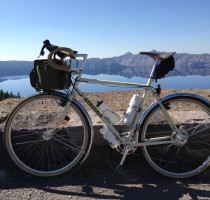
Paul's 1000 Mile Review
“Paul wrote a lengthy thoughful review. Below is just an excerpt. Read the full review here: http://bike.paullieberman.net/blog/soma-gand-randonneur-1000-mile-review "And the verdict is
It's a great bike and I'm really enjoying it. As far as the things that are unique about this bike, I'll take them one at a time.
Steel Frame
This is a no brainer for me now. I've had aluminium and carbon fiber bikes in the past and now I know I prefer steel. The ride is always great, the performance is great, and I know I can trust it.
650b wide tires
I'm sold on this now. I feel like I'm not giving up anything as far as speed and agility while gaining comfort, stability, and the ability to ride on any surface. This is really a win-win for me.
Low trail geometry
The jury's still out on this one. I like the responsiveness and how well it holds true around a curve. I certainly don't like the possibility of shimmy at speed, or the twitchy feeling when going too slow. Once advantage of low trail is that you can carry more weight in the front. This is great but I can also load up my touring bikes with a front load and never have any problems. If the main advantage of low trail is that it handles better around the turns on really fast downhills, then this is something I don't need. I'd be perfectly happy going a little slower if the trade off was more stability. So this may be the one feature that I don't care for. Then again the more I ride this bike the better I like it. It may be that after a while I'll come to appreciate the low trail more. We shall see."”Paul L., City, State
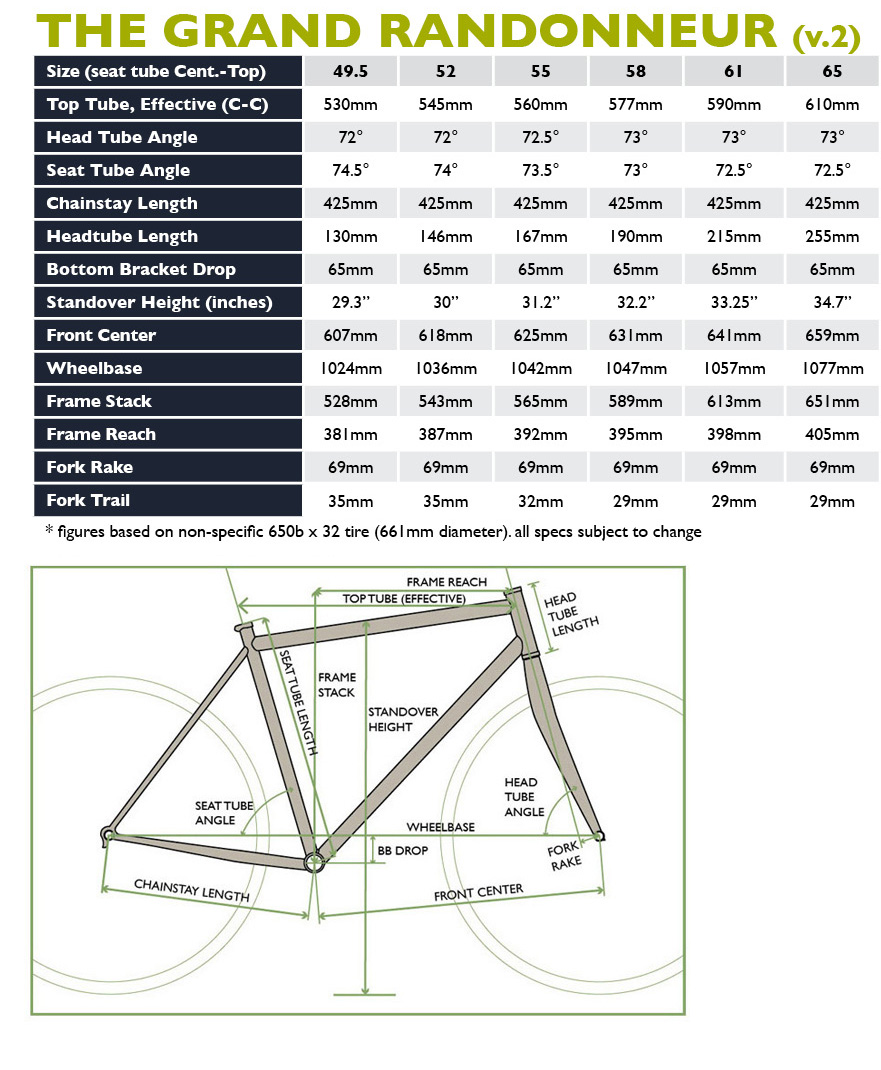
Grand Randonneur Frameset (v.2) (Light Touring/Randonneuring)
-
Cycle Seattle's Quick Impression on the Grand Randonneur
The Soma Grand Randonneur was recently shipped, and is a very compelling deal. It is a $500 frame/fork combo that was designed by Mike Kone of Boulder Bicycle and Rene Herse fame. Note: Soma is doing some great combo design deals lately. First Grant Petersen‘s design on the San Marcos, and now a low-trail guru’s take on a commodity frame. You’d be hard pressed to not want both!
The bike I rode is a 55cm (small for me) with a large porteur rack on the front. Good to add some weight and see how it feels with a bit of front load. In my short ride, I felt immediately at home on the bike, and really felt some of the benefits of the different front-end geometry. It was quick handling, but forgiving – not twitchy. As I slowed to a stop, I noticed there was none of the flopping I have on my higher trail bikes if I let go of the handlebars. OK – that’s kind of nice. But the thing I liked more is that on a slow climb, I didn’t have the bars slightly twisting back and forth with my pedal strokes. It tracked well at low speeds. Hmmm – I may like this sort of thing.
On turns, at medium and higher speeds, there was no uncertainty of where I was going. Perhaps it didn’t feel like it was “on rails” like my Rivendells, but there was no bad effects I could ascertain. As for riding no-handed, it was about like my Miyata. Not great, but doable, and I wonder if it’s not due to the high saddle, low bars on this slightly too small frame for me. http://stonehog.com/2013/11/21/low-trail-rides/ -
Handlebard's Grand Randonneur Review
... It’s a beautiful bike, with clean welds, and light tubing (my 61cm weighed in at 25.5 lbs with rack, fenders, and wheels). The color, which I expected to be an aesthetic problem for me, immediately grew on me. It’s unique, classic and even a bit sophisticated looking. Pump pegs, bosses for a third bottle cage, integrated rear brake stop are all nice features that add to the fit and finish. Decals are under the clearcoat.
The ride is more reminiscent of my 80′s Trek 560ex than my touring bike, yet it is at least as comfortable to ride. That is, as far as I remember… my other bikes have been collecting dust since the GR arrived. (Ah, new love!)
It’s my first 650b bike, so I am loath to make too many comparisons. I’m just having fun on it. Fun riding up the volcano, fun riding my favorite fast flat, fun getting my coffee in the morning. It’s even fun to look at while I drink my coffee.
One caveat. If you’re sniffing around Grand Randonneur as a touring bike, I’d encourage you to look elsewhere. The GR frame and fork are purpose built for randoneurring. The frame is light and sporty and I can imagine it being too lithe to handle a heavily load. Further, the rider is farther back towards the rear axle than on an intended touring bike. Even though there are rear rack mounting bosses, heel strike on the panniers would likely be a problem. I have not tried mounting a rack and panniers, nor intend to. Maybe that’s the chainstay length or maybe the seat tube angle. I’m no geometry expert.
.....
Further, climbing was actually fun. Each pedal stroke was like getting a push from an unseen force at the rear of the bike. This is a new sensation for me on a bike. And I love it. I wasn’t just going up this hill, I was accelerating up it. Thanks to John, a cyclist who I’ve been mailing with, I can give a name to this sensation. Jan Heine calls it ‘planing’ and it’s a result of a symbiotic rider and frame geometry. .
Read more....
http://handlebard.com/?p=41.
http://handlebard.com/?p=139
